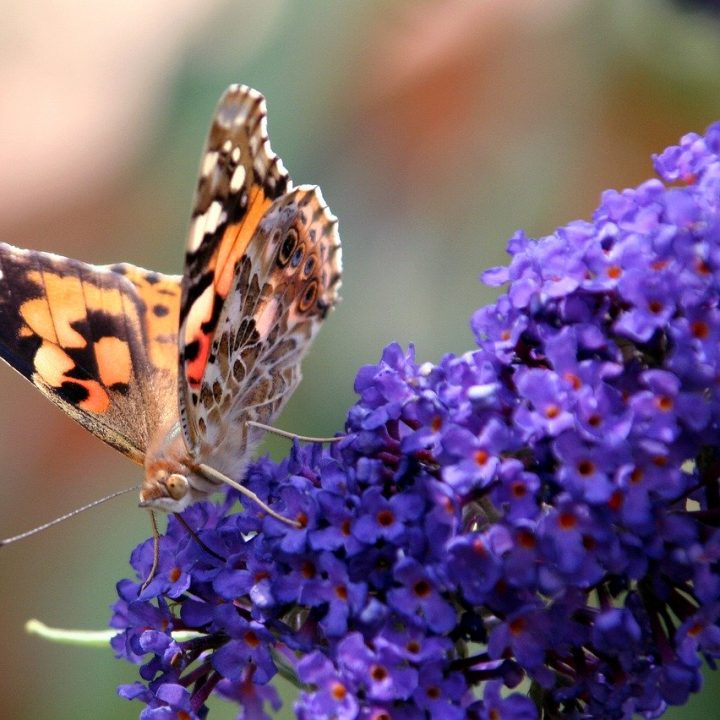Butterflies are more than beautiful, they’re a gardener’s best friend, for pollinating plants. To attract more butterflies to your garden, be sure to include the butterfly bush as a delightful flowering shrub for your garden and landscape.
Known botanically as the Buddleja davidii (aka buddleia), [1]https://www.missouribotanicalgarden.org/PlantFinder/PlantFinderDetails.aspx?taxonid=243250&isprofile=0&, the long conical flowers are filled with sweet nectar that is irresistible to all butterfly species. Buddleia is a great source of food for butterflies and other pollinators. Not only do the butterflies love the butterfly bush—hence the common namesake—but the flowers are long lasting throughout most of the summer.
As with all plants, there are multiple cultivars of the butterfly bush to choose from. Plant them alone as an attractive feature plant or as part of a collection. They are also fairly low maintenance, and will add a dramatic structure to your garden even when the flowers are spent thanks to their architectural seed heads.
Below, we’re taking an in-depth look at butterfly bushes, giving you advice on what variety might be best for your garden, and taking you through how to properly care for and maintain your buddleja throughout the year.
So keep reading to learn everything you need to know about this beautiful plant, that is sure to entice a kaleidoscope of butterflies into your garden!
By the way… do you know what a “flock of butterflies” is called? We’ve listed common terms below in order of our favorites first.
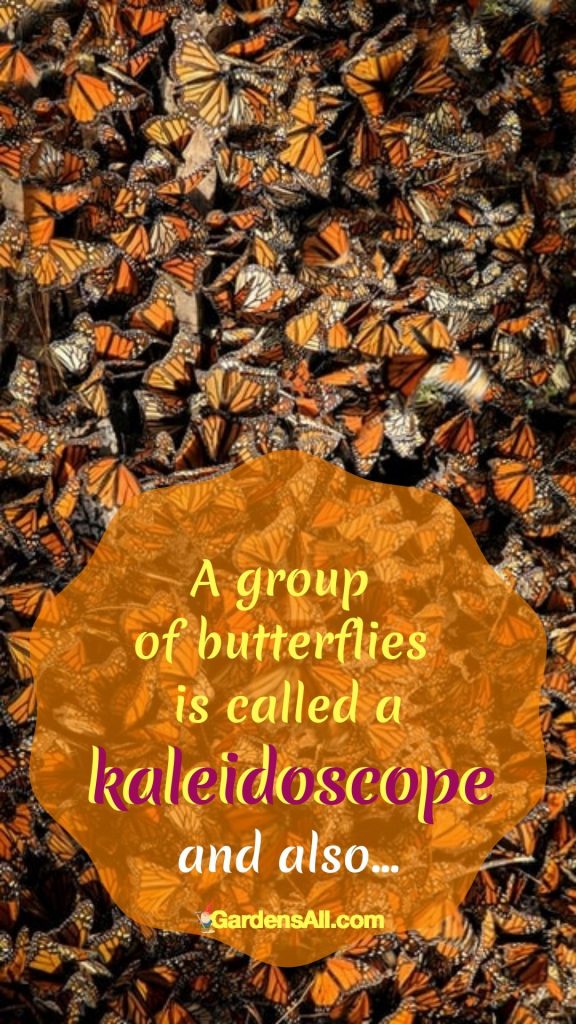
What is a Group of Butterflies Called?
- Kaleidoscope (the official name for a group of butterflies)
- Flutter
- Rainbow
- Swarm
- Rabble
Butterflies are insects in the Macrolepidopteran clade Rhopalocera from the order Lepidoptera, which also includes moths.[2]http://www.okiesformonarchs.org/tips_from_the_experts/what-do-you-call-a-group-of-butterflies/
Butterfly Bush Colors
Although most famously purple in color, buddlejas also come in a variety of other colors, all of which will be frequented by butterflies throughout the flowering period. The choice of multiple colors allows you to find a variety that is best suited to your current planting scheme, The butterfly bush blends in effortlessly with existing perennials and any annuals that you’re adding to your flower beds.
Purple and yellow flowering varieties are particularly good for encouraging butterflies into your garden, as they are within the color spectrum that a butterfly can see, allowing them to find it with a little more ease.
Other buddleija varieties such as white butterfly bush flowers are also attractive to butterflies with an enchanting fragrance that will fill your garden with a sweet scent all summer long. You can even also find multicolored butterfly bush varieties that will add extra interest to your outdoor space.
Butterfly Bush Varieties
When you’re looking for a buddleja, one variety that you’re almost guaranteed to come across is the ‘Buzz’ Butterfly Bush. The Buzz is a fantastic choice to go for, especially for beginner gardeners new to caring for a garden. It’s really low maintenance and bears sweetly scented flowers that draw flutters of butterflies into your garden.
The Buzz Butterfly Bush is also fairly compact and will only grow to around 4 feet tall. This makes it a fantastic addition to the back of borders, or as a stand alone feature plant that can be used as a natural focal point in your landscape design.
Depending on what color of butterfly bush you’d like to plant in your garden, we’ve listed some fantastic varieties below that will encourage these gorgeous pollinators into your garden and work well with your current planting scheme.
Purple Butterfly Bush Varieties
- Buzz Magenta Improved
- Santana
- Summer Beauty
- Cotswold Blue
Find more purple flowers here.

Yellow Butterfly Bush Varieties
- Sungold
- Honeycomb
- Golden Glow

White Butterfly Bush Varieties
- Les Kneale
- White Profusion
- White Ball
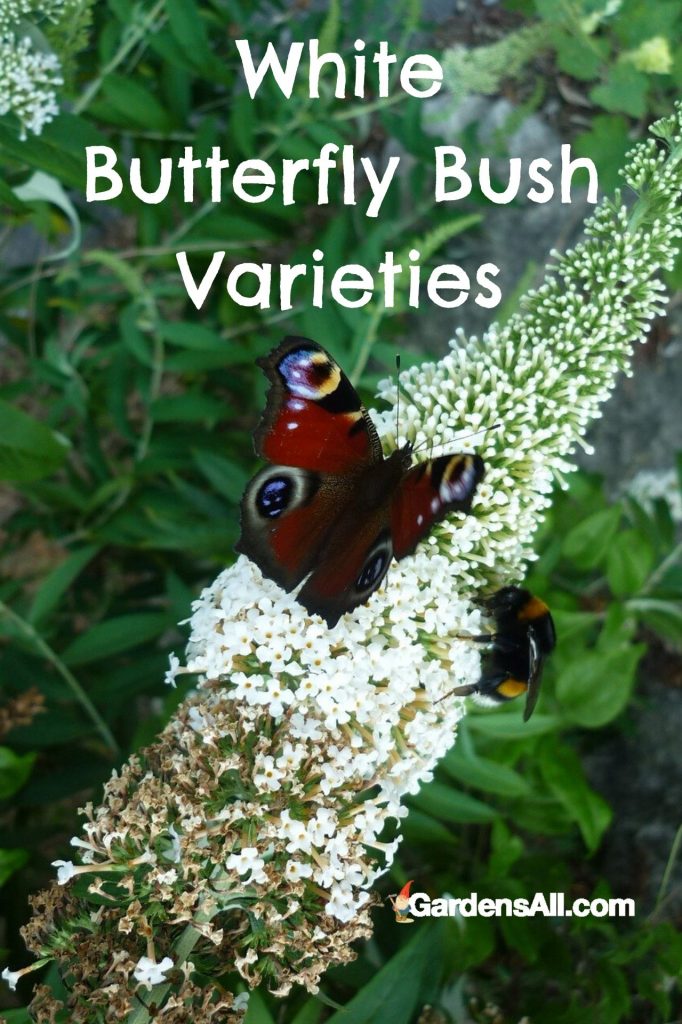
Multicolored Butterfly Bush Varieties
- Bicolor
- Tricolor
- Kaleidoscope
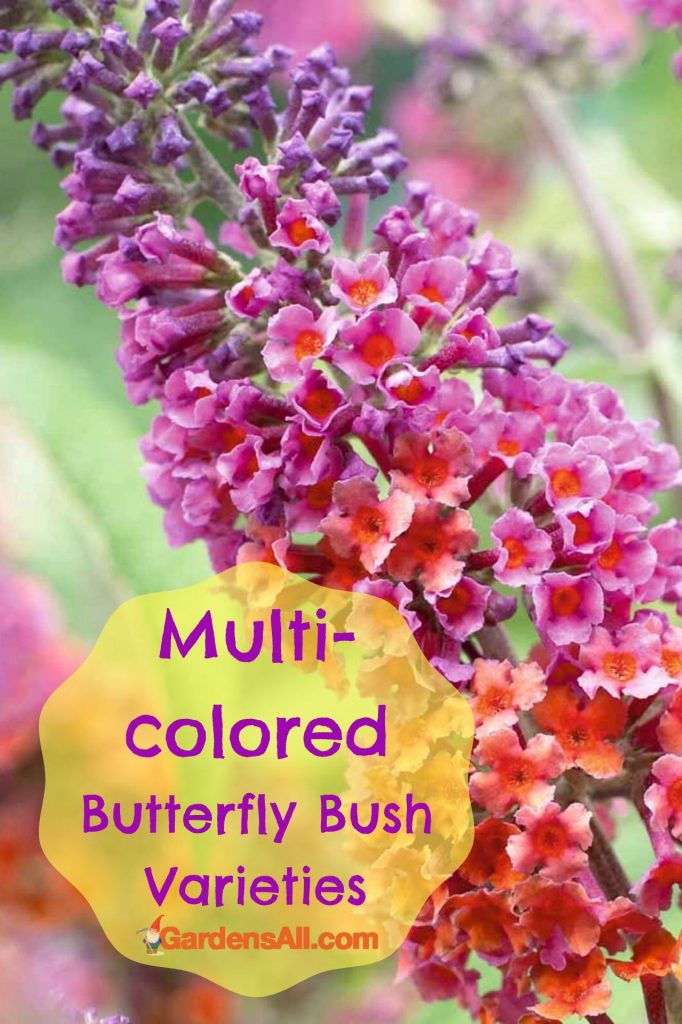
Whether you decide to go for one cultivar in particular, or choose to plant a variety of differently colored butterfly bushes, you’re in for many years of enjoyment with these beautiful and fragrant plants. Butterfly bushes play an important role for the butterflies and other pollinators, and in turn, for your garden.
Plant some butterfly bushes. You’ll be glad you did! Once they’re blossoming, be sure to have your camera ready to take photos and video—try some slo-mo—of the exquisite butterflies fluttering by.
Butterfly Bush Maintenance
All plants need a little bit of care and attention in order to grow as successfully as possible. Fortunately, butterfly bushes are amongst the easiest to care for and maintain.
Butterfly Bush Pruning
As many of you know, there are optimum times to prune certain plantings.
A general rule is to prune those that flower in spring after they’ve bloomed.
This allows new buds to form so that they bloom on the “old” wood the following year. Those shrubs that flower in summer should be pruned in winter or early spring because they flower on “new” or “current” wood. Minimal to zero pruning should be done in the late summer and fall due to winter kill of the new growth.
- FIRST: Prune your butterfly bush once a year in early spring, just as they begin to show signs of foliage regrowth.
Pruning a butterfly bush could not be simpler. Grab a pair of secateurs and remove the conical seed heads that have provided you with structure and interest throughout the winter. These can be added to your compost pile as part of the ‘brown material’, and will add goodness back into your garden.
- SECOND: reduce the current height of your buddleja by about half. This will make it much easier to see where you’re cutting as you progress, and will give you easier access to the base of the plant.
- THIRD: cut through each woody stem at around 12″ (30cm) above ground level, making your incision just above a bud or a growing shoot. It’s worth noting that cutting the stems at this height will keep the bush at a height of around 9′ (3 meters). If you’d like it to grow taller than this, cut the stems back to 2′ (60cm) above ground level.
- FOURTH: Completely remove any dead branches using a pair of loppers or a pruning saw, taking it all the way back to the base of the branch so that it’s flush with the trunk. Cut out any stems completely that are crossing or rubbing together, as this can cause open wounds that make the bush vulnerable to disease.
And that’s it. It’s really that simple! There are a few varieties that are an exception to this rule such as Buddleia Globosa. This beautiful golden globe butterfly bush flowers from the previous year’s growth and therefore doesn’t require hard pruning.
Pruning basics are the same for most woody plants, but good to follow the specific instructions for your plant variety.[3]https://www.uky.edu/Ag/Horticulture/QRLabels/Pruning.html
Pruning Butterfly Bush Like a Tree
A reader shared her preferred method for pruning butterfly bushes:
I love butterfly bushes. After about 3 or 4 years, I heavily prune the bottom of mine to form a tree, so to speak, leaving 3 to 5 main branches. I strip them completely up to about 2 feet. All the blooms are up top that way and makes it easier to work around.
~Angela Williams,
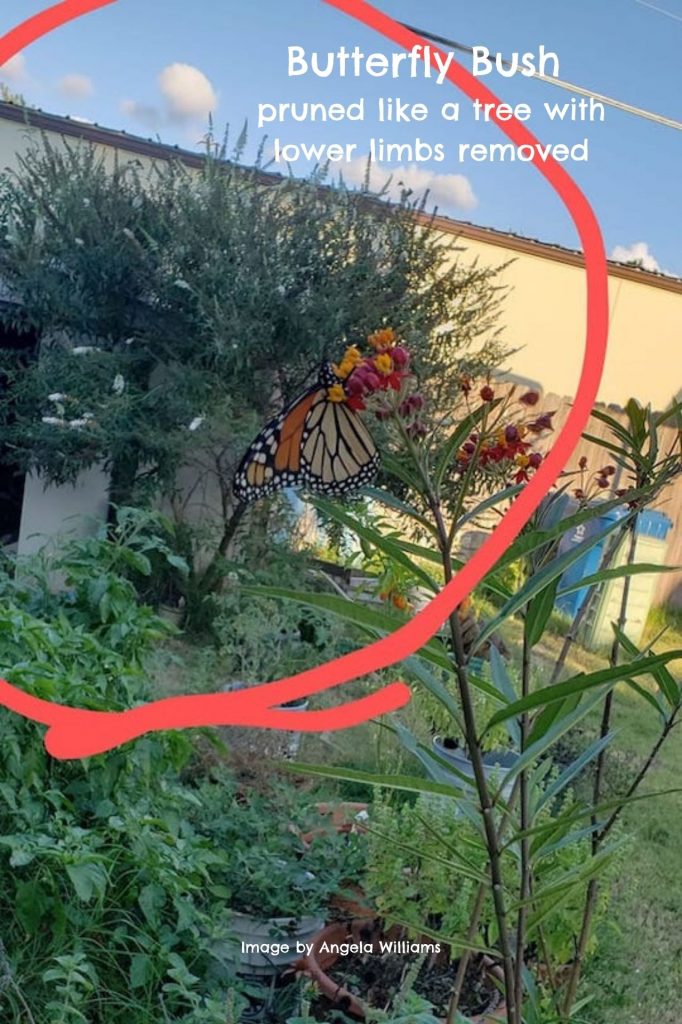
How to Keep Cats from Getting Butterflies
To Angela’s sharing, we responded:
That sounds like a great idea, and especially for those with cats! The black cat we have now, Mystique, tends to ignore butterflies, thankfully. But our previous deaf, white kitty, Priya, would hang out by the bush to stalk and catch some! ![]()
![]()
So your idea of trimming the lower branches sounds like it could be a good solution for anyone whose cats hunt butterflies!
Borders & Containers
Butterfly bushes are easy to grow in a variety of situations, and are equally happy being planted in flower beds, borders and containers. Bear in mind though, that whichever way you choose to plant your buddleia will impact how big it grows.
Butterfly bushes that are planted directly into the ground will grow much larger as they will have more room to spread their roots far and wide without any restriction. This is great if you’re looking for a tall, spreading plant, but be wary of it potentially overpowering and surrounding planting by shading it out and taking the lion’s share of nutrients from the soil.
Planting a butterfly bush into a container will certainly restrict growth as it will only have a confined space in which to spread its roots. However, container gardening is perfect for patio and courtyard gardens, or colder areas where planting in soil isn’t an option.
If you do choose to plant your butterfly bush in a container, you’ll want to repot it every couple of years. You can repot it into a larger pot if you have room for it to grow larger. If you don’t want your bush to grow larger, you can trim away some of the tiny roots tp keep the plant to soil ratio balanced
Too much root and not enough soil can cause your plant to dry out too quickly and not have enough nutrients to thrive.
Repot your plant ever couple years with fresh compost for essential nutrients.
Butterfly Bush Hedges
You may also wish to grow a series of butterfly bushes as a hedge. The butterfly bush can be a stunning feature throughout the summer and is guaranteed to be full of butterflies. However, a buddleja hedge has a disadvantage.
Buddlejas are deciduous, so during the colder months your hedge will consist of exposed branches that can seem unattractive. Further, after early spring pruning, as outlined above, for awhile it won’t be a hedge at all, but more of a series of small bare shrub stumps.
Don’t need a hedge for any bordering or fencing purposes? Then a deciduous hedge as part of a design feature, such as a butterfly bush hedge would be an attractive addition with a kaleidoscope of benefits.
Propagation
The butterfly bush is easy to grow and easy to propagate.
The quickest and easiest way of propagating is to take bush cuttings. Whilst the plant is actively growing during spring or summer, head out into your garden with a sharp pair of pruners and snip of any new growth that is at least 3 inches long. Immediately place these into a polythene bag to stop any moisture from evaporating, and head directly to your potting area.
Propagation Steps
- Make a mixture of compost and horticultural grit, and fill a small plant pot with this, ensuring that there are drainage holes in the bottom, then water this compost mix until it is moist but not soaking.
- Take your bush cuttings and remove all but the top two leaves.
- Dip the cut end into some rooting hormone powder then into the soil. Place one side of the cutting up against the inside of the pot.
- Place the pot into a well lit area, but out of direct sunlight.
- Keep the soil moist.
- You should begin to see root development within a few weeks, after which you can pot up each cutting individually to grow on.
Propagation by Division
You can also propagate butterfly bushes through division, and this is best done in either spring or fall, once the bush is about to begin growing or has finished for the year. All you need to do is carefully dig up your existing bush and, using a very sharp spade, divide the plant in half. Then replant into borders or containers, adding in plenty of organic material, and watch them regrow!
Fertilization
As with all plants, butterfly bushes require feeding throughout their growing season to make sure they grow healthily and are able to fight any disease that might try to take hold. The best way to do this is with fertilizer.
The best fertilizer to use for a butterfly bush is a granular fertilizer that can be added to the soil around the base of the plant and then watered in. This will slowly break down into the soil and will feed the bush gradually, rather than giving it the instant hit that comes from liquid fertilizers such as seaweed.
Another great way to feed your butterfly bush is to use organic compost, and apply as mulch at the base of the plant. There’s no need to work it into the soil, as it will be pulled down into the earth by worms and washed into it by any rain. Applying mulch over the organic compost is also a really good way to suppress any weeds that could be competition for the nutrients you’re butterfly bush needs.
Winter Care
Butterfly bushes are really hardy, and can survive temperatures all the way down to 20°F, however it’s always a good idea to give them some extra protection if they’re to survive the winter and grow back strongly next summer.
As soon as the temperatures begin to drop, apply a thick mulch of organic material to the base of the plant. This will help to retain any heat that exists deep down in the soil, and will prevent the ground from freezing deeply as well, acting as a layer of frost protection.
It’s tempting as well to remove the brown seed heads that were once beautiful flowers adorned with butterflies, but leave them in place! These seed heads will catch any frost and protect the stems from frosting over. They also give you attractive, architectural interest throughout the winter, so they’re worth leaving in place for that as well.
Finally, if you get a heavy fall of snow, head outside and very gently shake the butterfly bush so the snow falls off it. This will reduce the extra weight being added to the stems and branches, and will prevent them from snapping off, which can lead to open wounds that disease can get into.
If your butterfly bush is growing in a container, you can also move this into a frost free greenhouse or shed to overwinter. You’ll need to water it to keep it healthy, however this should be done sparingly and only every two weeks in order to prevent it from getting too cold and wet, which can lead to it rotting.
RELATED: Plants for Attracting Butterflies
BUTTERFLY BUSH:
When the flowers are spent, leave the brown seed heads of the butterfly bush on the plant. They protect the stems and provide architectural interest in winter landscapes.
Conclusion
Following all of these tips will help you grow gorgeous butterfly bushes in your garden that will provide you with amazing displays of color, and give butterflies and other pollinating insects a reliable source of food throughout the summer.
Take some time to make sure you choose the right plant for the right place. Keep your plant well fed and watered in summer, and protected throughout the winter and you’ll be rewarded with dazzling flowers full of butterflies and fragrance, year after year.
Wishing you health, wealth and an abundance of happy plants!
We are an online gardening publication sharing all things garden related! Including urban farming, family gardening, homesteading, gardening for profits, and more. We’re all about growth!
References

